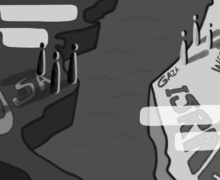Abroad : Break from glitz of urban China reveals widespread poverty in rural life
Most postcards from China will show off the razzle-dazzle Shanghai skyscrapers or the imperial majesty of Beijing. Westerners walk these streets and marvel at China’s development.
To me, Shanghai looks like a spaceport straight out of ‘The Jetsons.’ And the streets are chock full of girls toting expensive handbags and bobbing up and down in malls stretching for miles.
The hope around here: This must be China’s future; this must be the New China.
But China’s reality is far from glittering apartments with Gucci attaché cases. The majority of Chinese people, 53 percent, still live in rural areas. This is where the roads are more narrow, the sights less fantastic. In China’s rural areas, many live in small one-room houses without clean water or central heating, let alone extravagant luxuries like a shopping mall down the street. This is the Real China we don’t see, not the New China we do.
I’ve had a glimpse of this Real China during my visits to the rural areas of interior China near the city of Xi’an. Our seminar group toured a farming village, where poverty was on a scale I have never before seen but only heard about in my grandfather’s stories about farm life during the Great Depression.
The pathways between houses were worn dirt alleyways — a far cry from my neighborhood or the tree-lined streets of Walnut Avenue in Syracuse. The houses seemed cramped and were made of bricks with terracotta roofs. There were gardens for food instead of front lawns, and the few men around lit up gritty cigarettes.
Small kids ran around our group and looked on with curiosity. As we went further, more and more would join to get a good look at the ‘wai guo ren,’ the foreigners. It turned into a parade marching through the small village. The kids looked, not out of hate but curiosity. One little boy asked to be picked up because he had never seen anyone so tall.
The adults, though tough on the outside, were kind. They took their place in life with pride, not sorrow or anger. They were happy to work hard and see their efforts pay off. The mayor of the town showed us the new health clinic. He, along with other villagers, seemed happy because things were visibly improving. Some houses even had modern entryways, electricity and color televisions flashing through windows.
‘The lives of the villagers are very hard but improving,’ said Tony Lu, our Xi’an tour guide. ‘I look forward to the future of my country.’
For me, this was a long way from Syracuse, but for these farmers, their everyday realities were probably farther away from their fellow countrymen in the high-end streets of Shanghai. It’s an example of China’s tremendous gap between life in the coastal cities and the interior countryside.
City-dwellers make two and a half times as much as the rural Chinese, and although China has 800,000 millionaires, 400 million people live on less than $2 a day, according to The Economist. Perhaps the greatest economic success story of the past 30 years has been the Chinese government’s ability to lift hundreds of millions out of that poverty, but there are still hundreds of millions stuck in it.
It brings into question the idea of Chinese meritocracy, or the ability to move up in income and social status. How does the future of a baby born to a Shanghai socialite compare to that of the child born to a farmer near Xi’an?
Before we pass judgment on China, however, we need to hold up a mirror to the United States. In America inequality has increased from 1980 to 2005. During that time span, more than 80 percent of the total increase in Americans’ income went to the top 1 percent of income earners. In 2004, the top 20 percent of American households held more than 84 percent of the country’s wealth, and the bottom 40 percent held 0.2 percent.
Throughout this same time span, the Chinese government began a program of openness that allowed incomes and the gross domestic product to rise. More recently, President Hu Jintao, among others, have pledged to spend more on social programs and quality education in rural areas. In comparing the two, it seems as though the United States is making an effort to take away from its future, and China is making an effort to invest in its future.
It is not a static question of capitalism vs. communism anymore. It’s question of whether or not both China and the United States can bridge the gap between rich and poor. Will both countries be able to break the cycles of poverty that ensnare so many people?
New China’s skylines are beautiful and its shops top notch, but it still remains an inequitable society. But let’s remember Real China, whose people live a life of subsistence, not abundance. It is my hope this will change for the better, not only for this country but for America as well.
Andrew Swab is a junior magazine journalism and international relations major. His columns appear occasionally, and he can be reached at ajswab@syr.edu.
Published on February 16, 2011 at 12:00 pm





